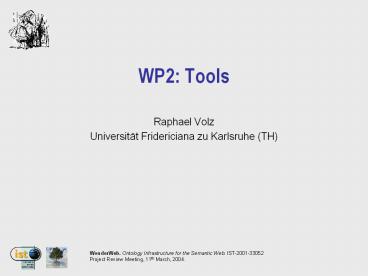WP2: Tools - PowerPoint PPT Presentation
Title:
WP2: Tools
Description:
Multiple systems (FACT ,Hoolet, DLP) to reason with ontologies ... Original file is used for visualisation of change. user specific formatting is preserved ... – PowerPoint PPT presentation
Number of Views:18
Avg rating:3.0/5.0
Title: WP2: Tools
1
WP2 Tools
- Raphael Volz
- Universität Fridericiana zu Karlsruhe (TH)
2
WonderWeb Tools
Tools now use OWL, the W3C standard for Web
ontologies
3
WonderWeb Tools
KAON SERVER Infrastructural KernelApplication
Server using Semantic technologies formanagement
of hosted components
4
KAON SERVER Functionality
- Functionality of common Application Server
- Flexible handling of Semantic Web
modules(dynamic registering and unregistering) - FaCT
- Racer
- Ontobroker
- KAON RDF stores
- KAON Ontology stores
- Sesame
- Extensible for future developments
- Generalization of RDF APIs (towards RDF Net API)
5
KAON SERVER Architecture
6
KAON SERVER Semantic technologies
- Ontology is used for
- component discovery
- API discovery
- classification of tools
- implementation tasks
- ? ASSW is semantically enhanced application
server!
7
WonderWeb Tools
Lift Extract light-weight ontologies from legacy
information sourcesDB Schema, XML Schema, UML
Models, Java Documentation
8
OntoLiFT
- Describes heuristics for extracting light-weight
ontologies from important legacy resources - Relational Database Schema
- Logical Schema found in running DBs
- XML Schema Languages
- Generic formal approach building on Regular Tree
Grammars - UML Software Specifications
- Static Aspects of Software modelled in Class
Diagrams - JavaDoc Software Documentation
- Text Mining techniques to extract ontologies from
textualDocumentation
9
LiFT Rel. DB Example
10
WonderWeb Tools
OilEd Visual Editor for creating OWL ontologies
11
What is OilEd?
- A simple ontology editor.
- Low cost, easy editor.
- A platform to explore how to use a reasoner.
- Originally intended as ademonstrator, now
widelyused (gt2000 downloads). - Initially targeted at OIL,supports DAMLOIL,and
now supports OWL.
12
Reasoning
- KB translated to equivalent DL model, and passed
to a reasoner. - Spots inconsistent definitions
- e.g. contradictions in cardinality constraints or
value restrictions. - mad cows!
- Organises the classification hierarchy
- Discovering new superclasses.
- Particularly useful when using defined classes.
- Subtle side-effects
- Superclasses inferred due to domain/range
restrictions. - One shot connection to the reasoner.
- Allows temporary inconsistency
- Communication with reasoner via KAON SERVER
13
WonderWeb Tools
ReasonersMultiple systems (FACT,Hoolet, DLP)
to reason with ontologies Common Interface (DIG)
proposed and agreed upon (Racer, OWLP)
14
Reasoners
- Reasoners developed during the project (WP2) were
crucial to the success of the standardisation
activity. - Why ? W3C standardisation requires demonstration
of implementation experience, in particular - FaCT
- Hoolet (1st Order reasoner)
- KAON DLP Prototype
15
DIG Interface
- A common interface to DL systems
- Supported by FACT, FACT, Racer, OWLP
- A new KRSS.
- XML Schema for concept language.
- Using HTTP for communication.
- Simple, Level 0 approach
- Sufficient to support simple, one-shot
applications, e.g. OilEd - Largely developed in WonderWeb project
16
WonderWeb Tools
OntoDiffOntology Change DetectionMethodology
plus practical tool support
17
Versioning tool OntoView
- Goal tool for (ordinary) ontology engineers
- helps to specify complete information about
changes - Functions
- compare versions of ontologies
- show propagation of change
- allows specification of conceptual relation
- distils the transformation operations
- patters of operations can be specified
18
Comparing ontology versions
- What should be compared?
- not textual representation (like diff)
- formatting is not important
- could be different representations for same
construct - not logical theory
- small change might affect whole ontology
- instead look at intended definition of classes
and properties - groups of axioms that form a definition
- follows ideas of ontology engineer
- gives a heuristic representation of the change
19
(No Transcript)
20
WonderWeb Tools
Further Tools Driving Theory and Practice of Web
Ontology Field
21
Thank you !
22
Change detection procedure
- Assume RDF-based ontology languages
- Ontologies are parsed and stored as RDF triples
- group statements resulting from one definition
(first level XML tree) - identify group by rdfID / rdfabout statement
ltowlClass rdfID"Person"gt ltrdfssubClassOf
rdfresource"Animal"/gt ltrdfssubClassOfgt
ltowlRestrictiongt ltowlonProperty
rdfresource"hasParent"/gt
ltowlallValuesFrom rdfresource"Person"/gt
lt/owlRestrictiongt lt/rdfssubClassOfgt lt/owlClas
sgt
about Person
Person rdftype damlClass Person rdfssu
bClassOf Animal Person rdfssubClassOf anon_1
anon_1 rdftype damlRestriction anon_1 owlonPr
operty hasParent anon_1 owlallValuesFrom Person
23
Change detection - 2
- Versions are compared by aligning groups of
statements about same concept / property - order is used in case of multiple occurrences
v1
v2
about Person
about Person
Person rdftype owlClass Person rdfssubClassO
f Animal Person rdfssubClassOf anon_1
anon_1 rdftype owlRestriction anon_1 owlonPro
perty hasParent anon_1 owltoClass Person
Person rdftype owlClass Person rdfssubClassO
f Animal
about parentOf
about parentOf
parentOf rdftype owlProperty parentOf rdftype
owlObjectProperty
parentOf rdftype owlProperty
parentOf rdftype owlObjectProperty
24
Change detection - 3
IF existold ltA, Y, Zgt existnew
ltX, Y, Zgt not-existnew ltX, Y, Zgt THEN
change-type A
- Rules are used to describe change types
- language specific
- requires computation of RDFS closure
- i.e. all statements should be made explicit
- Example find a change in a OWL slot restriction
IF existold ltX, rdfssubClassOf, Y1gt
ltY1, rdftype, owlRestrictiongt ltY1,
owlonProperty, Y2gt ltY1, owlallValuesFrom,
Zgt existnew ltX, rdfssubClassOf, Y1gt
ltY1, rdftype, owlRestrictiongt ltY1,
owlonProperty, Y2gt not-existnew ltY1,
damltoClass, Zgt THEN logicalChange.localPropertyV
alue X
25
Change detection - 4
- Original file is used for visualisation of change
- user specific formatting is preserved
- Strong points
- generic mechanism
- can be used with all RDFS based languages
- language specific parts are encoded in rules
- RDF data model hides a lot of syntactic changes
- existing tools are used for parsing, state
maintenance and computation of RDFS closure































